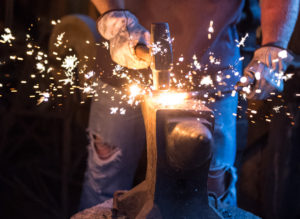Finding a historical connection in blacksmithing
by Samantha Nelson
Rob Miller has been a multifaceted artisan for years, but his primary craft is building 18th, 19th and some 17th century guns. Miller says blacksmithing and building guns goes hand-in-hand;parts of the gun such as the lock mechanisms and the barrel all require blacksmithing for the guns Miller crafts.
Miller also produced several lanterns through tinsmithing for the blockbuster movie Pirates ofthe Caribbean: On Stranger Tides and for the Fox television series Sleepy Hollow.
Miller is a fan of history, particularly of the colonial-era, which influences his preferred style of gun building and other craftsman creations. For him, it’s all about the history connection.
“The world is what you make of it and that’s kind of what I’m doing,” he says.
The art of blacksmithing was once common in the towns of Southeast Ohio in the late 18th, 19th and early 20th centuries. The sound of the clanking metals as they were struck with hammers could be heard on just about any given day.

An authentic replica of a 19th century blacksmith shop is in McConnelsville in Morgan County, located behind the Evelyn True Button House.
In the center of the shop is a black forge with a cranking handle and a tube connected to the forge from underneath it. Tools line the walls and an anvil sits on a tree stump to the right of the forge. A small, portable forge and a brick forge that twists out of the roof like a crooked chimney are on the forge’s left.
The forge has a hearth where the metal is placed into the fire. Blacksmiths can use a variety of different metals — steel, aluminum, iron ore — when it was easily accessible — brass and copper, just to name a few.
A blacksmith requires a forge to heat the metal to a malleable state of about 1,400 degrees Fahrenheit. At that temperature, the metal will “go right through you,” Miller says.
Beginning in July, Miller and Randy Baldwin, also a local, started providing blacksmithing demonstrations. Miller began teaching Baldwin some of his acquired skills during the demonstrations.
The shop wasn’t always in its present location, which runs along an alley way parallel to EastMain Street. The materials that make up the small building were part of an old building that sat on the ground of the Ohio Coal Company.
Much of the equipment was originally from a blacksmith shop that was once operated and owned by William S. McDaniel earlier in the 20th century in Malta, a town located just across the Muskingum River from McConnelsville. The blacksmith shop replica is referred to as McDaniel’s.
Baldwin says the demonstrations and other community initiatives, such as the Morgan County Historical Society and the Morgan County Community of the Arts, are part of an effort to draw
people into town and become involved in the local activities, such as watching the duo’s
people into town and become involved in the local activities, such as watching the duo’s
blacksmith work.
Using the forge in the center of the shop to heat their metals, the two men aim to provide demonstrations on the first Friday of every month.
Every blacksmith has their own style and preferred blacksmithing techniques, and Miller says he has his own distinct style as well. “It’s called rough,” he says, laughing.
Baldwin, who was interested in blacksmithing and took it up as a hobby, is working on setting up a blacksmith shop in his barn at home, and says that there is a growing interest in the revitalization of blacksmithing.
“There are more backyard blacksmiths out there than we probably realize,” Baldwin says.
Whether it’s for the historical presentation or an interest in picking up a new hobby, the blacksmith shop offers locals and visitors a taste of the past.
Baldwin, who was interested in blacksmithing and took it up as a hobby, is working on setting up a blacksmith shop in his barn at home, and says that there is a growing interest in the revitalization of blacksmithing.
“There are more backyard blacksmiths out there than we probably realize,” Baldwin says.
Whether it’s for the historical presentation or an interest in picking up a new hobby, the blacksmith shop offers locals and visitors a taste of the past.
SEO
Southeast Ohio strives to spotlight the culture and community within our 21-county region and aims to inform, entertain and inspire readers with stories that hit close to home. Southeast Ohio is the first student-produced regional magazine in the country. Every semester, approximately 25 students enrolled in Ohio University’s E.W. Scripps School of Journalism produce an issue of the magazine, which is published in print twice a year. The staff generates story ideas, conducts interviews, writes stories and designs the magazine in only 15 weeks. The magazine has won several Regional Mark of Excellence Awards from the Society of Professional Journalists.
Related posts
What’s Inside
- Behind the Bite (65)
- Features (120)
- In Your Neighborhood (99)
- Photo Essay (4)
- Read the Full Issue (8)
- Talking Points (45)
- The Scene (14)
- Uncategorized (3)
- Web Exclusive (5)
- What's Your Story? (20)




Find us on Social Media